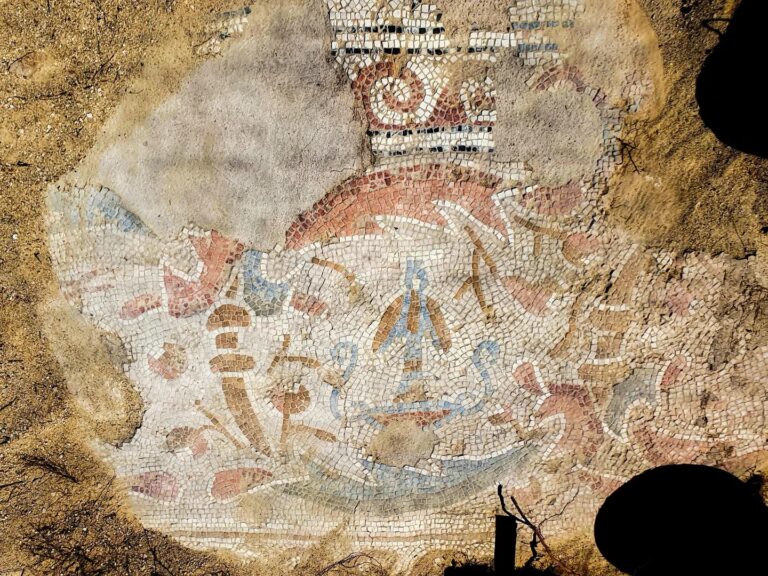
The re-uncovered mosaic at the Byzantine nunnery near ShohamCredit: Gilad Stern / Israel Antiquities Authority
For the second time, a Byzantine-era nunnery has been accidentally uncovered by the Israeli military, the country's Antiquities Authority explained on Monday.
The Byzantine nunnery dates to about 1,500 years ago, and is locally called the Horbat Hani, or Buri el Hanaya, Haaretz reported.
Bits of its ruins were first discovered in 2002 when the army was building a road there for its own purposes, says Issy Kornfeld, director of the excavation on behalf of the IAA.
A salvage excavation promptly ensued and the archaeologists discovered an early Christian religious structure – but not the usual church and monastery.
No, this was a church and a convent, he explains.
It is not the only female-oriented early Christian complex in Israel. A magnificent Byzantine basilica unearthed in Ashdod by the sea had female ministers, archaeologists reported in 2021.
At Horbat Hani (aka Horvat Hani), among the original finds were dedicatory inscriptions to an abbess; a tower; structures that seem to have been the nuns’ equivalent of hermit cells; signs of economic activity – production of wine and olive oil; and a subterranean burial complex. But only for women and children, it seems. No men.
The preponderance of evidence led the archaeologists to conclude that it had been a nunnery and, based on the local name of Buri el Hanaya, that it commemorated the name of the biblical Hannah. She was one of the two wives of Elkanah, the other being the fruitful Peninnah. Mortified at being childless and reportedly pestered severely by Peninnah – “And her rival vexed her sore, to make her fret, because the Lord had shut up her womb” (1 Samuel 1:6) – Hannah prays and vows, if she has a son, to dedicate him to the service of God and never to cut his hair.
And she did have a son, who would be Samuel: “And when she had weaned him, she took him up with her, with three bullocks, and one ephah of meal, and a bottle of wine, and brought him unto the house of the Lord in Shilo” (1 Samuel 1:24).
This twice-revealed nunnery is where Hannah had been buried, and the name of the local Arab village preserves her memory, IAA archaeologist Dr. Eitan Klein postulates.
“In the original excavation, two buildings were uncovered – one of which was a church paved with a colorful mosaic depicting faunal and vegetal scenes, an entrance hall, the nuns’ dormitories, hermit cells, a tower with rooms and a crypt, an underground burial complex. The other building included a kitchen, a refectory [dining hall] and an inn for pilgrims,” says Kornfeld.
And then the site was covered up with earth for the sake of its preservation, as is done in archaeological sites that are not conserved and developed for public view; and the army continued to train. And the site was largely forgotten, at least by the military, it seems. The IAA did not forget and from time to time would inspect the spot.
And such is army training life: in 2019, the site was accidentally partly uncovered again, this time by a blast. Oops. A “small area” of the ancient convent was damaged, the IAA reported.
And thus was born the initiative to “leverage” the incident, involve soldiers in re-excavation and cleanup, explain the concepts involved in environmental conservation, teach them about the heritage and the history of the Land of Israel and, in short, make a community project out of the whole thing and teach them about responsibility, explains Kornfeld – including, presumably, where to aim things during training.
So it came to pass that over the last month, several dozen soldiers engaged in re-excavating the Byzantine convent of Horbat Hani, in the framework of a educational project initiated together with the IAA: “The Nature Defense Forces Project: Officers Take Responsibility for the Environment.”
Asked if the site hadn’t been known before the first time the Israeli army damaged it in 2002, Kornfeld says that historic archaeological surveys from the time of the British mandate (before independence in 1948) did reveal “something there,” but they didn’t know what and one can’t excavate every intriguing site in Israel. “We only discovered the substance of the site after the first accident,” he says.
As seems to have been quite usual, the convent continued to operate after the Muslim conquest, but its fortunes apparently worsened – as did the economies of other Christian institutions in the Holy Land at the time. “During the Islamic period, the monasteries slowly declined,” Kornfeld says. “There was less demand for their wine, perhaps; and fewer pilgrims. Finally, it was abandoned in the late eighth century. Yet the local Muslim villages continued to bury women there, because of the sacred tradition of women there.”
What now? Is it to be re-covered, again, until hit by a mortar maybe? In fact, most of the precious mosaics have been covered up again with soil, for their protection.
The IAA says it does plan to make the site more accessible, starting with soldiers – say, bringing groups of trainees there once or twice a month for educational purposes and while about it – since this is what army day trips are like – to help clean up and maintain the place.
“Right now it’s still in a firing zone,” Kornfeld acknowledges. But in the future, with the cooperation of the army, he hopes to make it accessible to the general public. Meanwhile, members of the public can visit the parts of the church mosaic that remain partially visible, with the advance permission of the IDF Central Command, at phone number 02-530-5042.
READ MORE: BBC puts world spotlight on Sfyria: Greece’s disappearing whistled language.